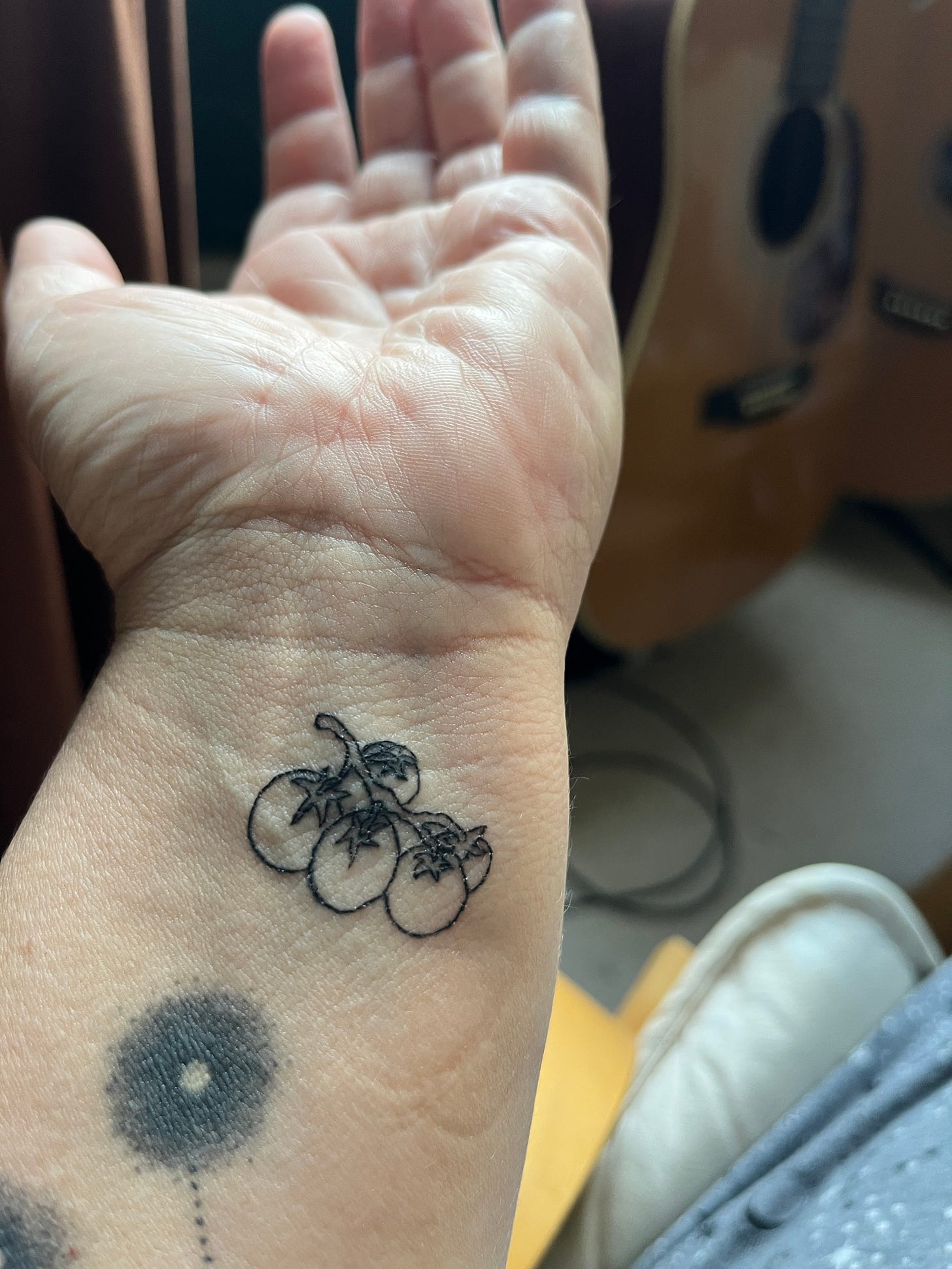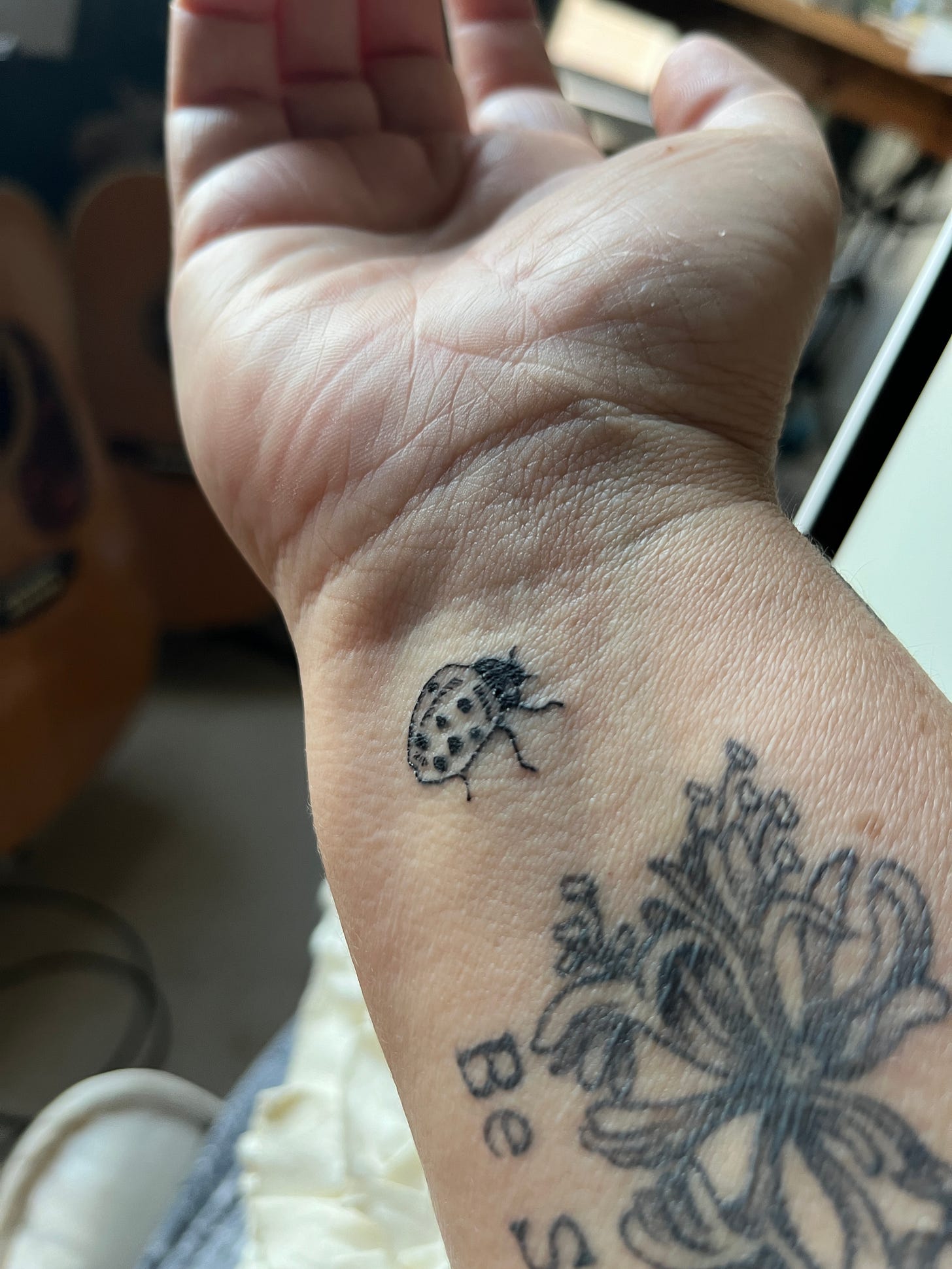If a writer could tattoo, what would it look like?
Or maybe writing isn't as lonely as I think it is
I got two new tattoos last week from a local artist in town. She runs a gallery and is headed to an MFA program come the fall. She started doing tattoos out of the back of her gallery in town just this year.
As she bent over my arm, outlining a delicate ladybug and a cluster of tomatoes, I asked her why she decided to start doing tattoos.
“Well, the money,” she said. The tattoo gun buzzed in the quiet of the room. “But, also, when I paint, I spend a lot of time alone in my head in a way I don’t think is always good for me. I wanted to do something that was still art, but more social. With tattooing, I get to talk to people. I like that.”
I nodded and we chatted for the rest of the forty-five minutes or so it took to finish the two tiny tattoos. We talked about being artists and I shared about the currently dismal state of publishing. She asked what I was working on, so I told her about the essays I’ve been writing, a series looking back on a career as a college professor.
“I have no idea if anyone would ever want to read the essays, but I like writing them,” I said.
“I think they’d be interesting,” she said and proceeded to list several specific reasons why people would find them interesting.
We talked about the college where she had been a student and where I teach, though I never had her in a class. We talked about how envious I sometimes am of performance artists, who get to see the effects of their art in person, at least some of the time. We talked about that balance between spending time in your head as an artist and interacting with other people. It was a thing I didn’t have to explain to her. She got it.
It was one of those lovely, unexpected conversations, reminding me that it’s good to be able to talk to another artist who understands all the pain and joy that comes with that in a way that other people just sometimes don’t quite get, no matter how hard they try to bridge that gap.
I’d already been thinking a lot about art and community and audience. I write to understand the world and I can’t imagine ever not doing that. At the same time, I’d like at least some of the time to close the circle and share those words with an audience. This is where publishing comes in and makes that simple step so much more complicated than it feels like it should be. How do you get your words out there, into the world?
What is the writing equivalent of doing tattoos? Tattooing is still art, but art that’s shared in a way that’s totally unique. You cannot tattoo at a distance. You have to be in the same room, close together. You have to touch the other person’s body. It is a ritual, one that cannot be performed alone. It forces you out of that lonely space that is necessary in order to be an artist, but also, yes, not a place you want to spend too much of your time.
How do you set up shop as a writer and share your work in a way that’s as intimate as that? I don’t know what the answer is. I’m still trying to figure it out.
This week, I also listened again to a podcast interview with Kate DiCamillo, the middle grade author of books like Because of Winn-Dixie and The Tale of Despereaux. DiCamillo had so many beautiful things to say, including this quote about what we do as writers, which is going on my Wall of Writerly Inspiration:
“We have been given the sacred task of making hearts large through story. We are working to make hearts that are capable of containing much joy and much sorrow, hearts capacious enough to contain the complexities and mysteries…of ourselves and of each other.”
In addition to that gorgeous insight, DiCamillo talks about reading and writing as communal. This is not the way I generally think of writing, but, of course, writing and reading are communal. Even when we are reading all by ourselves, we’re not really alone. We are there with the characters, but also with the person who created those characters. When someone reads a story or essay I’ve written, I am there with them through my words. We are having a conversation, even if it’s a very unique sort of dialog.
DiCamillo explains that for her, the story is never finished until someone she’ll never know reads it. That person, this perfect stranger, they sit and they exist in this world that she created. They exist in a world that somehow came out of her. And in the reading, they both exist in that world together.
Of course, Kate DiCamillo no doubt has an easier time imagining those strangers. She meets them at signings and reading and events. She gets e-mails and letters from her readers. For writers like me, there’s a lot more imagination involved, to reach out into the world and imagine that reader somewhere. A complete stranger to me. Picking up one of my books or maybe even now reading this essay or something else I’ve written.
They sit and they exist in this world I’ve created with words and sentences. They exist in a world that through some magic I don’t really understand, came from inside my head and heart and body. And while they’re reading, we exist in that world together. Which is all to say, maybe writing isn’t as lonely as I think it is.






I just wanted to say: Hi! I’m over here hanging in my hammock in the sun in my garden in North West England and also in your world and a happy combination it is too!
This is such a reassuring post. I find it hard to imagine those strangers too. I've only had short stories published atm, but I'm working on my first novel and there's always a fear in the back of my mind that no-one will read it. Imposter syndrome sucks. (love the tattoos btw!)